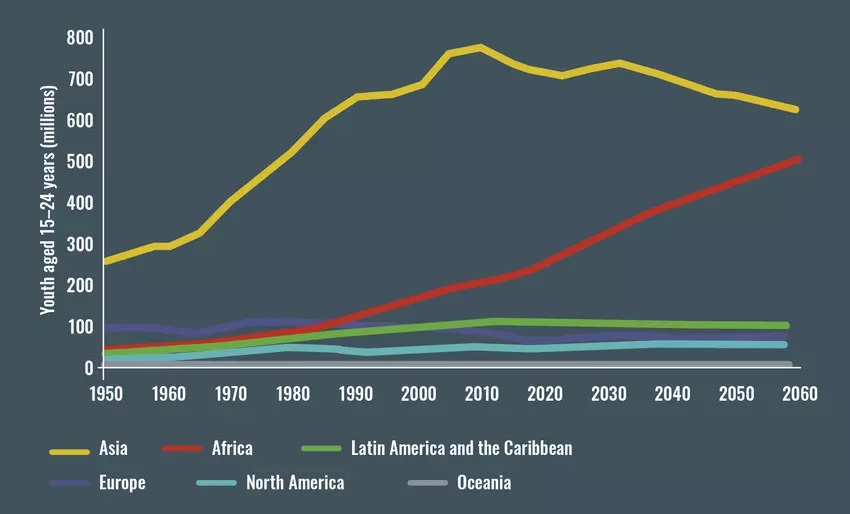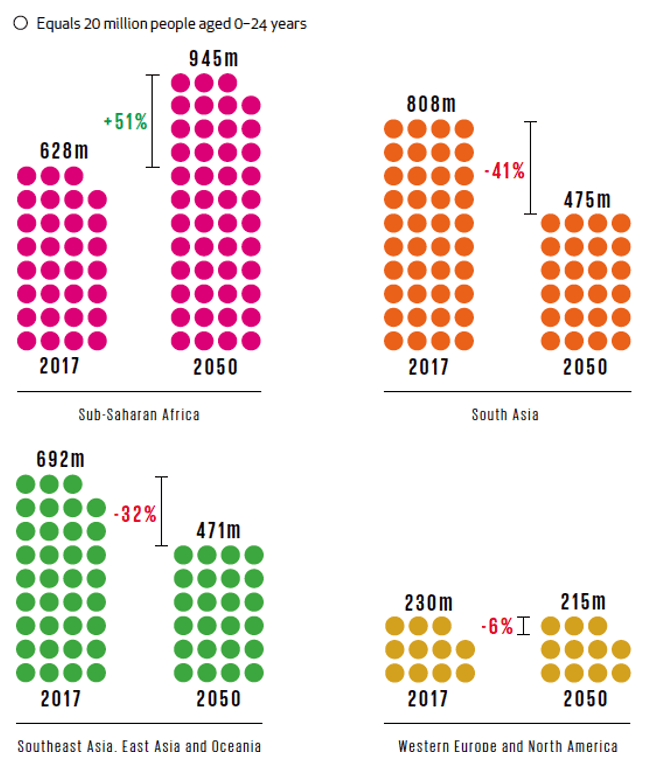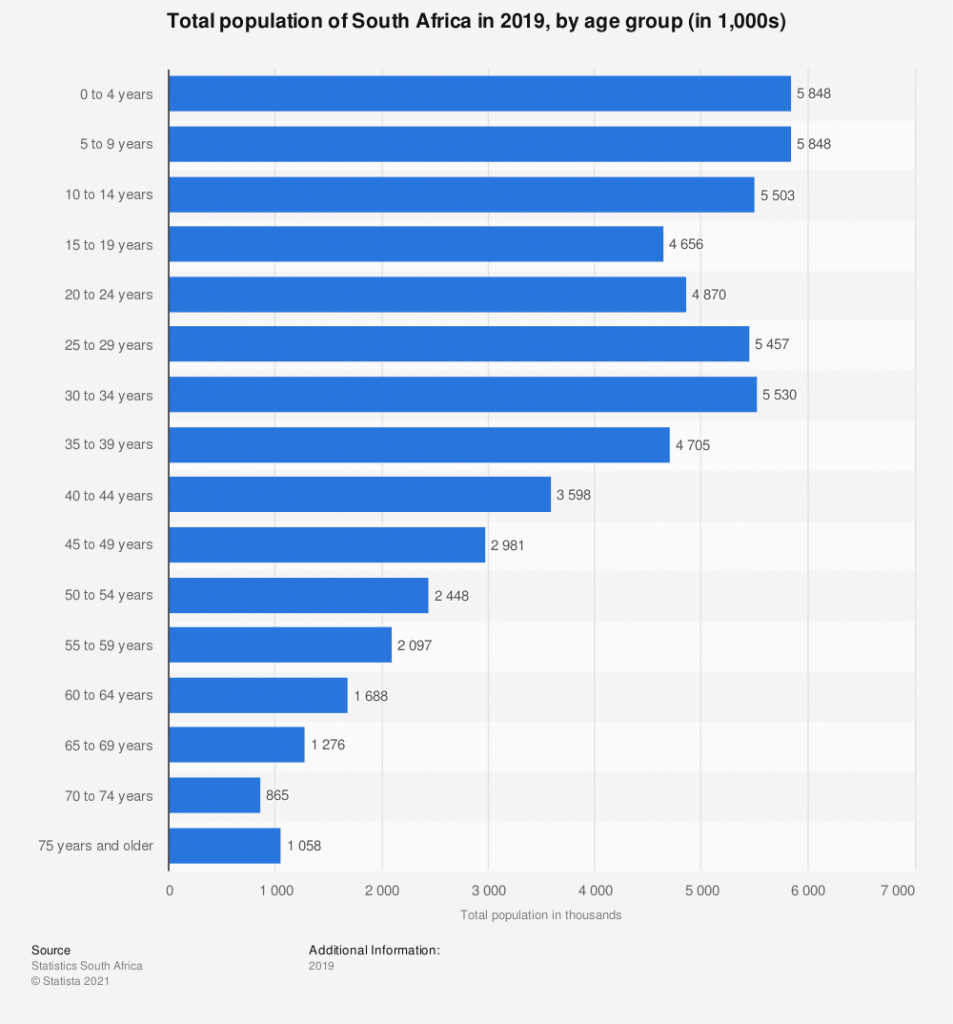The African continent has the fastest growing youth population in the whole world with 60 percent of its population under the age of 25. South Africa alone has a youth population of 20.6 million. It is, therefore, not surprising that an African country holds the record for having the most youthful population. Niger, has the youngest population in the whole world, with a median age of 15.4. This means that at this age point (15.4 years), half of its population is younger and half older. Africa’s average age is 19 years old. The population growth rate in Africa is projected to continue growing until 2050. It has been forecasted that by 2050 Africa’s young population (0-24 years), will increase by nearly 50 percent. In other continents like South America, Europe, and Asia, high population growth has been witnessed for many decades, however, this growth has now slowed. The majority of the populations in these continents are adults.

Africa is currently the only continent where the youth population is increasing. In population studies and Economics, having a youthful population has both positive and negative implications. One positive is that having a youthful population is a guarantee for an abundant supply of labor. Economists categorize labor as one of the forms of production amongst, land, capital, and entrepreneurship. Having a youthful population will be advantageous for countries that are endowed with natural resources or industries. These sectors are labor-intensive. The sad reality witnessed especially in Africa has been that countries lack adequate economic activities to realize this potential.
One likely disadvantage of having youthful populations is that these countries have a high dependency, ratio. This means that too many young people rely on a few working adults. This tends to affect the tax base of a country. In addition, young children need health care attention, for example, immunizations. This is expensive for a country to provide. Young people also need education. The provision of schools and teachers is expensive as well.

South Africa’s youth population demographics
As of 2019, South Africa’s population increased and counted approximately 58.4 million inhabitants in total. 21.85 million of these were roughly 19 years or younger. South Africa alone has a youth population of 20.6 million, making up 35.7 percent of the country’s total population of about 57.7 million people. An important change in the profile of the South African youth population since 1960 has been their increasing share of the national population. Their share of the national population increased from 17.9% in 1960 to 20.5% by the end of 2009. The cohorts of youth who contribute to this sizeable increase were born when fertility was relatively high. These youths benefited from overall improvements in infant, child and adolescent survivorship.

Youth unemployment in South Africa
Employment is a key economic indicator and it is sensitive to the business cycle. The size and trend in the youth population have implications for socio-economic development. A relatively large number of people of the active working ages can be a demographic asset for a country. But the potential economic benefit of the young population can only be realized if they are healthy, well-educated, have a good economic environment and live in a stable and predictable political environment.
The majority of youths in South Africa are without gainful employment. Many of them are equally vulnerable and out of any significant social welfare system. This has been the trend in other African countries as well like Namibia, Nigeria, Zimbabwe, Angola and Mozambique. One major contributing factor is that the absorption rate of youth into the labor market has declined over the years. Labor market absorption is a measure of the proportion of working-age adults that are employed.
Young people are disproportionally affected by unemployment in South Africa because demand for labour is highest for skilled employees. In the late 1990s and early 2000s, the country’s economic policy shifted to a high productivity, technology-led growth path. This path was intended to stimulate investment in skills development and higher wages. This resulted in a drop in the employment of unskilled labour. The youth unemployment rate in South Africa is largely a contribution of youth (15 – 34 years) with less than a matric qualification. The unemployment rate for these youth stands at 55%, compared to just 8% for young people with a tertiary qualification (certificate, diploma or degree).

This challenge of youth unemployment has been prevailing for decades in South Africa’s economy and in much of Sub Sahara Africa too. This has led policymakers and leaders to sound warning trumpets as they are increasingly concerned with this issue. Graca Machel warned
“Even though our youth have the potential to transform Africa, if neglected, they could exacerbate poverty and inequality while threatening peace, security and prosperity”.
Graca Machel
The effects of unemployment have been documented and some have been witnessed in reality. Unemployment has been proved to be a major cause of various social and psychological challenges among young people. Unemployment may increase risky behavior among young people. Some young people may engage in prostitution or sex work in a desperate attempt to survive. Some may end up engaging in illegal but high-paying activities such as drug dealing. There could be a link between unemployment and the crime rate. For example, South Africa has the third-highest crime rate in the world. There is a notably high rate of assaults, rape, homicides, and other violent crimes. These crimes have been attributed to factors, such as high levels of poverty, inequality, unemployment, and social exclusion. Long-term unemployment and negative labour market experiences lead to decreased self-esteem, depression and discouragement, which, in turn, has negative effects on the likelihood of an employer hiring youth.
Economic growth prospects in South Africa
South Africa’s youthful population presents a significant opportunity to promote the growth and advancement of the economy. Factors such as disparity in educational quality and poverty, among others, however, continue to pose a huge risk in South Africa’s economy.
South Africa has had some glorious years in the past, for example, employment peaked in 2008 to approximately 13,8 million when the economy was better. However, during the recession of 2009 and 2010, approximately 806 000 persons lost their jobs. According to statistics from the International Labor Organization (ILO), the estimated youth unemployment rate in South Africa in 2020 was at 55.75 percent.
With a growing number of unemployed young people, policymakers have urged African countries to channel resources toward their young populations. This has been prescribed as one of the solutions to reduce the poverty trap among youths, which potentially could breed insecurity and instability. Currently, the slow-growing economy in South Africa is struggling to create viable opportunities for young people, especially those without educational qualifications and advanced skills. The youth aged 15–24 years continue to be the most vulnerable in the South African labour market. The unemployment rate among this age group was 55,2% in the 1st quarter of 2019. Among graduates in this age group, the unemployment rate was 31,0%.
The burden of unemployment is concentrated amongst the youth (aged 15–34 years) as they account for 63,4% of the total number of unemployed persons. Almost 4 in every 10 young people in the labour force did not have a job. The result has been that most unemployed youths are often targeted by unscrupulous persons who claim to be able to secure employment for them for some form of payment. Many desperate jobseekers are swindled by their hard-earned money. Meanwhile, the graduate unemployment rate is still lower than the rate among those with other educational levels. This could mean that education is still the key to these young people’s prospects improving in the South African labor market. There is therefore a strong case for the government and private sector to channel more efforts in having many young people educated and acquiring technical skills. Addressing education will indirectly address the challenges of unemployment.
Across much of the rest of Africa, the youth are poor and are stuck in “waithood”. Most young people cannot afford to form families and households and are unable to become fully independent and partake in the responsibilities of adult life. Young people have attempted to escape this trap through other strategies, such as venturing into the informal economy, migrating to other countries or becoming involved in criminal activities. Some even join extremist groups such as Al-Shabaab and Boko Haram, among others, as a way to survive.
Conclusion
This article has highlighted how Africa’s population is ballooning at a faster pace than the rest of the world. This has presented the continent with both opportunities and challenges which need to be addressed by governments and policymakers. The article has centered on South Africa as a case mainly because of its standing as an economic powerhouse in Africa, the so-called ‘Egoli‘. Despite the relatively strong economy of South Africa, it hasn’t been able to absorb millions of unemployed youths into the labor-force. Most affected have been young people aged between 15–34 years as they account for 63,4% of the total number of unemployed persons. Despite this, however, The graduate unemployment rate is still lower than the rate among those with other educational levels, meaning that education is still the key to these young people’s prospects improving in the South African labour market. Education is still the key to these young people’s prospects of improvement in the South African labour market. There is therefore a strong case for the government and private sector to channel more efforts in having many young people educated and acquiring technical skills. Addressing education will indirectly address the challenges of unemployment.
________________________________________________________________________________________________________________
IVolunteer International is a 501(c)3 tech-nonprofit registered in the United States with operations worldwide. Using a location-based mobile application, we mobilize volunteers to take action in their local communities. Our vision is creating 7-billion volunteers. We are an internationally recognized nonprofit organization and is also a Civil Society Associated with the United Nations Department of Global Communications. Visit our profiles on Guidestar, Greatnonprofits, and FastForward.


